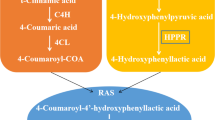Abstract
Resveratrol is an important antioxidant that confers several beneficial effects on human health. 4-coumarate coenzyme A ligase (4CL) and resveratrol synthase (RS) are key rate-limiting enzymes in the biosynthetic pathway of resveratrol. Using gene fusion technology, the fusion gene, 4CL::RS, was constructed by the 4CL gene from Arabidopsis thaliana and RS gene from Arachis hypogaea. DNAMAN analysis showed that the fusion gene encoded a 964-amino acid protein with an approximate weight of 104.7 kDa and a pI of 5.63. A prokaryotic expression vector containing Nco-I and EcoR-I restriction sites, pET-30a/4CL::RS, was identified by liquid culture bacterial PCR, enzyme digestion, and sequencing, and then used in the induction of expression. Subsequently, a biosynthetic pathway of resveratrol was constructed in Escherichia coli BL21(DE3) that harbored pET-30a/4CL::RS. The recombinant strains were induced to express the fusion protein at 28 °C for 8 h. After bacterial cells were disrupted by hypothermic ultrasonication, the 4CL::RS fusion protein was thoroughly separated from tags using Ni–NTA affinity chromatography, and then detected by SDS-PAGE analysis. When the recombinant strains expressed the fusion protein, the precursor, p-coumaric acid, was converted to resveratrol. In the present study, the final concentration of resveratrol derived from 1 mM p-coumaric acid was 80.524 mg/L, with a 35.28 % (mol/mol) conversion yield.







Similar content being viewed by others
References
Arai R, Ueda H, Al Kitayama, Kamiya N, Nagamune T (2001) Design of the linkers which effectively separate domains of a bifonctional fusion protein. Protein Eng 14(8):529–532
Athar M, Back JH, Tang XW, Kim KH, Kopelovich L, Bickers DR, Kim AL (2007) Resveratrol: a review of preclinical studies for human cancer prevention. Toxicol Appl Pharmcol 224(3):274–283
Bülow L (1990) Preparation of artificial bifunctional enzymes by gene fusion. Biochem Soc Symp 57:123–133
Bülow L, Mosbach K (1987) Preparation of bifunctional enzyme complexes by fusion of two genes. Ann NY Acad Sci 501:44–49
Burns J, Yokota T, Ashihara H, Lean MEJ, Crozier A (2002) Plant foods and herbal sources resveratrol. J Agric Food Chem 50(11):3337–3340
Chong J, Poutaraud A, Hugueney P (2009) Metabolism and roles of stilbenes in plants. Plant Sci 177(3):143–155
Donnez D, Jeandet P, Clément C, Courot E (2009) Bioproduction of resveratrol and stilbene derivatives by plant cells and microorganisms. Trends Biotechnol 27(12):706–712
Doré S (2005) Unique properties of polyphenol stilbenes in the brain: more than direct antioxidant actions; gene/protein regulatory activity. Neurosignals 14:61–70
Ferrer JL, Austin MB, Stewart CJ, Noel JP (2008) Structure and function of enzymes involved in the biosynthesis of phenylpropanoids. Plant Physiol Biochem 46(3):356–370
LaVallie ER, McCoy JM (1995) Gene fusion expression systems in Escherichia coli. Curr Opin Biotechnol 6(5):501–506
Li H, Xia N, Förstermann U (2012) Cardiovascular effects and molecular targets of resveratrol. Nitric Oxide 26(2):102–110
Lim CG, Fowler ZL, Hueller T, Schaffer S, Koffas MA (2011) Hight-yield resveratrol production in engineered Escherichia coli. Appl Environ Microbiol 77(10):3451–3460
Noel JP, Austin MB, Bomati EK (2005) Structure-Function relationships in plant phenylpropanoid biosynthesis. Curr Opin Plant Biol 8(3):249–253
Robinson CR, Sauer RT (1998) Optimizing the stability of single-chain protein by linker length and composition mutagenesis. Proc Natl Acad Sci USA 95(11):5929–5934
Sun AY, Wang Q, Simonyi A, Sun GY (2010) Resveratrol as a therapeutic agent for neurodegenerative diseases. Mol Neurobiol 41:375–383
Vogt T (2010) Phenylpropanoid biosynthesis. Mol Plant 3(1):2–20
Wang Y, Chen H, Yu O (2010) Metabolic engineering of resveratrol and other longevity boosting compounds. BioFactors 36(5):394–400
Watts KT, Lee PC, Schmidt-Dannert C (2006) Biosynthesis of plant-specific stilbene polyketides in metabolically engineered Escherichia coli. BMC Biotechnol 6:22
Winkel BSJ (2004) Metabolic channeling in plants. Annu Rev Plant Biol 55:85–107
Xue F, Gu Z, Feng J (2004) LINKER: a web server to generate peptide sequences with extended conformation. Nucleic Acids Res 32(suppl 2):W562–W565
Zhang Y, Li SZ, Li J, Pan X, Cahoon RE, Jaworski JG, Wang X, Jez JM, Chen F, Yu O (2006) Using unnatural protein fusions to engineer resveratrol biosynthesis in yeast and mammalian cells. J Am Chem Soc 128(40):13030–13031
Zhang J, Yun J, Shang Z, Zhang X, Pan B (2009) Design and optimization of a linker for fusion protein construction. Prog Nat Sci 19(10):1197–1200
Acknowledgments
This work was supported by a grant from the State Forestry Administration 948 Project (Program No. 2013-4-07), P. R. China.
Author information
Authors and Affiliations
Corresponding author
Additional information
Erhao Zhang and Xuefeng Guo have contributed equally to this work.
Rights and permissions
About this article
Cite this article
Zhang, E., Guo, X., Meng, Z. et al. Construction, expression, and characterization of Arabidopsis thaliana 4CL and Arachis hypogaea RS fusion gene 4CL::RS in Escherichia coli . World J Microbiol Biotechnol 31, 1379–1385 (2015). https://doi.org/10.1007/s11274-015-1889-z
Received:
Accepted:
Published:
Issue Date:
DOI: https://doi.org/10.1007/s11274-015-1889-z




